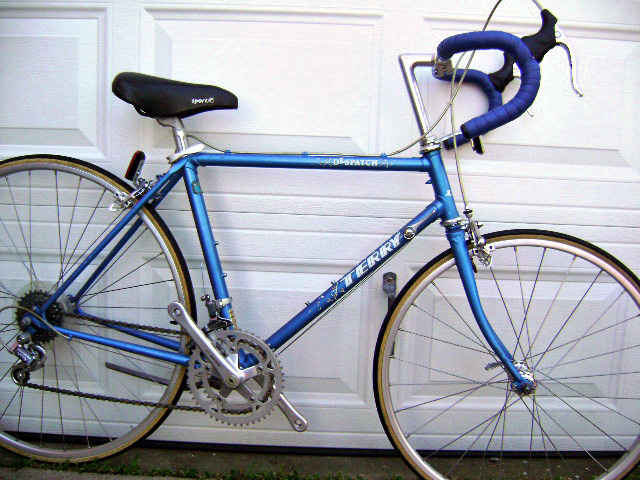You don’t see too many bicycles with a front wheel smaller than the rear. In the hundred plus years since the modern chain-driven bicycle came to fruition, the default design configuration has been to have two equally sized wheels. But for a time starting around 1984 till about 1996, a number of manufacturers large and small were making bikes with smaller front wheels for racing against the clock. The US Olympic team very prominently used them to unprecedented success at the 1984 Olympics in Las Angeles, and soon the moniker “funny bike” was applied to them since those bikes exuded speed in the same way that “funny car” dragsters did.
The smaller front wheel wheel (typically 24” tubular or 650C) combined with a “cowhorn”-style handlebar provided the same position as the lowest, most aerodynamic grip on a standard drop. The smaller front wheel and reduced height of the front of the bike were thought to reduce aerodynamic drag. The rear wheel was generally the standard 700C size, since going to a smaller wheel at the back would have required oddly large chainring tooth counts to retain overall gear ratios; the larger diameter of the rear wheel would have lower rolling resistance as well.
By the late 1980s funny bikes were being used by top athletes in time trials on the road as well as pursuits on the velodrome. In team events, the small front wheel was considered especially desirable as it allowed the team members to draft very close off the rear wheel in front of them. Funny bikes were also used to some success by mulitsport athletes (ie triathletes), though those athletes eventually migrated to bikes with identically sized wheels as they had to be self-sufficient while racing. Unlike professional cycling with team cars, mechanics, and spare wheels, triathletes need to carry their own spare tires. And identically sized wheels meant carrying just one size of spare.
Funny bikes were dropdead sexy, but were they faster? Well, that is a question that is tough to answer today as it was back then. Some riders undoubtedly were faster on a funny bike, but others maybe not. Taller riders are unlikely to benefit from a small front wheel as a lot of un-aerodynamic head tube would be presented to the wind. The addition of aerobar extensions meant that being narrow on the bike might reduce drag as much as being low. By the mid 1990s, funny bikes on the road somewhat standardized on a 650C/700C configuration, while pursuit bikes still frequently used 24” as well as 650C fronts.
Funny bikes were never sanctioned for mass-start racing on either the track or road, and in the late 1990s the UCI banned them from racing altogether, along with introducing much more severe restrictions on frame geometry and rider positioning. The 1996 Olympic Games were more or less the last great hurrah for funny bikes. Today almost all the records set on funny bikes have been broken by riders using standard bicycles (almost always 700C front and rear), and most experts in the field will assert that rider positioning is ultimately more important than the size of the front wheel.
Another type of bike with small front wheels exists. There was a trend that began in the mid-1980s or so for making bikes to fit short stature women. One of the primary issues with making bikes for shorties is that designing a bike with a short top tube often means that the pedals may foul the front wheel during slow speed maneuvers. An exaggeratedly small front wheel (24” clincher) eliminates that potential hazard. Terry Cycles, one of the first companies really targeting female cycling demographic, was closely associated with this type of bike, and this type of bike is sometimes called a “Terry”. For a time, many manufacturers including Raleigh, Miyata, Fuji, and others made these bikes for the entry-level market segment. For the most part, this design has fallen from favour as bikes with front and rear 650C wheels retain more normal aesthetics and avoid the higher US import tariff applied to bikes with two different sized wheels. Due to their weight and relaxed geometry, these “Terry” bikes are hardly as wild as the true funny bikes used for pursuits and time trials.
…We're riding townies, adventure, and mountain bikes. Find recommendations on our store page. As Amazon Associates we earn from qualifying purchases.


